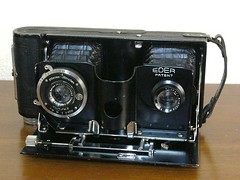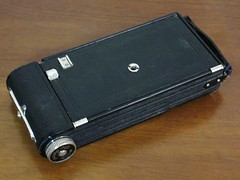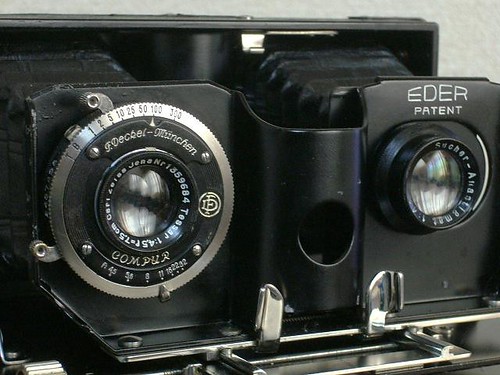Eder Patent Kamera

|
| image by eBayer Yalluflex (Image rights) |
The Eder Patent Kamera was made by the German company Eder in the early 1930s.[1] It is a twin-lens camera, but not a reflex: the viewing lens serves a focusing screen beside the camera. Bentzin made a similar camera, the Primarette shortly afterwards, with the viewing and taking cameras arranged one above the other. A particular feature of the camera is automatic parallax-error correction. There is a rail running diagonally across the bed on the viewing side, which guides the viewing lens rightwards as the bellows is extended (i.e. as the camera is focused closer).
According to McKeown, the camera was made in 4.5x6cm, 6x6cm and 6x9cm sizes, and in roll film and plate versions.[2] It was offered with an f/4.5 Tessar, f/4.5 Schneider Radionar or f/4.5 Xenar in a Compur shutter as the taking lens and with an f/4.5 Edar Anastigmat or f/4.5 Radionar as the viewing lens: examples seen have other lens combinations.
In the 1980s, Linhof made a mugshot camera, the Quadrophot, along similar lines. The intended purpose of the Eder camera is not known, but perhaps it was the same.
Notes
- ↑ See the dates of Patent linked below. The serial number of the lens on the example pictured here is from 1931.
- ↑ McKeown, James M. and Joan C. McKeown's Price Guide to Antique and Classic Cameras, 12th Edition, 2005-2006. USA, Centennial Photo Service, 2004. ISBN 0-931838-40-1 (hardcover). ISBN 0-931838-41-X (softcover). p.254.
 
|
 
|
 
|
| Eder Patent Kamera, 4.5×6cm, Tessar 7.5cm f/4.5. Pictures by eBayer Yalluflex. (Image rights) |
Links
- Patents relating to the camera, at Espacenet, the patent search facility of the European Patent Office:
- German Patent 560203, Kamera mit Einstellsucher (Camera with adjustment viewfinder), filed April 1930, granted September 1932 to Hans Eder, describing the basic design of the camera, including the movement of the finder lens to correct parallax error.
- German Patent 562771, Aus Sucher- und Aufnahmekamera bestehende Doppelkamera (Double camera comprising viewing and taking camera), filed September 1931 and granted March 1933 to Hans Eder, showing the design adjusted for roll film: specifically the detail that one film spool must be housed between the two bellows, and how the lensboard is shaped (that is, the bulge between the lenses) to permit the camera to be completely folded despite this. British Patent 384629 is equivalent.
- Examples of the camera at previous Westlicht/Leitz Photographica Auctions:
- Eder camera serial no.1125 for roll film, with 7.5cm f/4.5 Tessar (taking) and f/4.5 Sucher-Anastigmat (viewing), sold at the 34th Auction.
- Eder camera serial no.1221 for roll film, with the same lenses as above, sold at the 21st Auction.
- Eder/Rodenstock camera serial no.5 for 4.5x6cm plates, with Rodenstock 9cm f/4.5 Doppel Anastigmat Eurynar serial no.445757 (taking) and 445728 (viewing). The camera is engraved with Rodenstock's brand on the folding bed, and does not have 'EDER PATENT' on the lensboard. The auctioneer's notes speculate that the camera may have been made by Rodenstock, or by Eder for Rodenstock (both Munich companies). Sold at the 30th Auction.
- Eder camera serial no.116 for 6x9cm plates, with 10.5cm f/4.5 Xenar serial no.491173 (taking) and 509153 (viewing), and with focusing loupe at the rear. Also sold at the 30th Auction.

|
| Front assembly. Picture by eBayer Yalluflex. (Image rights) |
 
|
| Automatic parallax correction coupled with the focusing mechanism. Pictures by eBayer Yalluflex. (Image rights) |